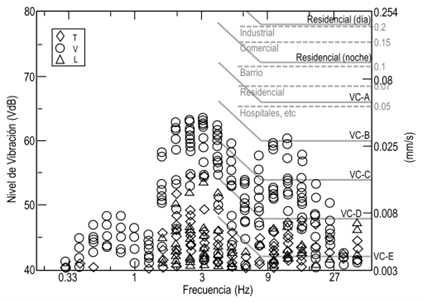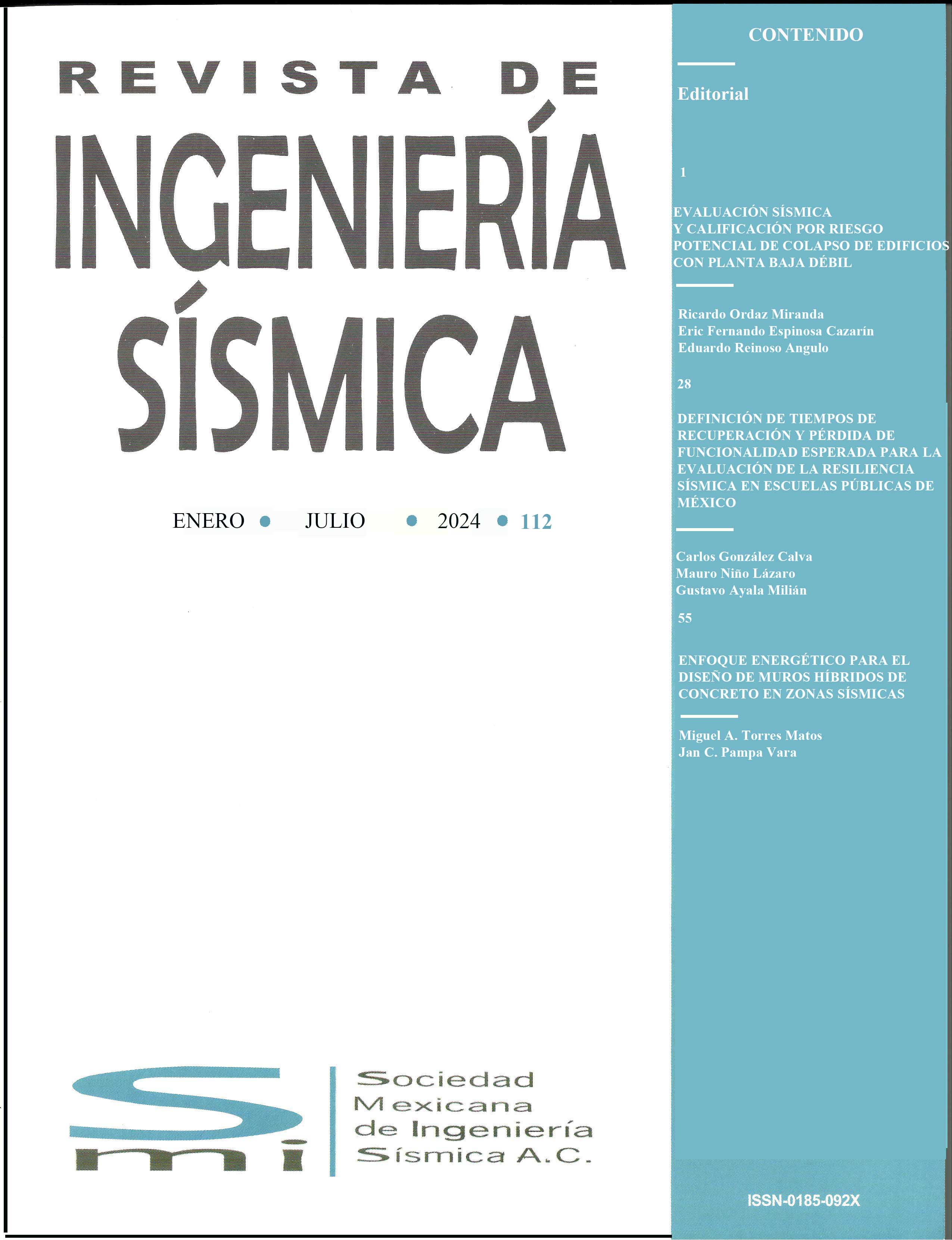STUDY TO DETERMINE THE INFLUENCE OF METROBUS TRANSIT ON THE COMFORT OF THE INHABITANTS
DOI:
https://doi.org/10.18867/ris.114.670Keywords:
comfort, standards, vehicular traffic, vibration level, spectral representationAbstract
The construction of new public transportation systems, such as the Metrobus (MBus) in Mexico City, and new roadways generates discontent among people due to the noise and vibration they cause. These disturbances are mainly perceived due to the heavy vehicles that travel on these avenues and streets. Following complaints from several people regarding the damage and inconvenience caused by the MBus passing near their homes, sound and environmental vibration tests were conducted on the roads where this transport operates. The objective of these tests was to determine the vibration levels caused by the MBus and to understand the noise levels it generates. The results of the measured signals were compared with those specified by various standards, including Mexican, German, American, British, and ISO standards. These comparisons allow for the evaluation of whether the noise and vibration levels generated by the MBus comply with international and national standards, and if additional measures are necessary to mitigate the negative effects on the residents' quality of life.
Downloads
References
ANSI s1.11 (2004). Specification for octave-band and fractional-octave-band analog and digital filters. American National Standards Institute.
BS Std. 6841 (1987). Guide to measurement and evaluation of human exposure to whole-body mechanichal vibration and repeated shock. United Kingdom Standards.
BS 6472-1 (2008). Guide to evaluation of human exposure to vibration in buildings Part 1: Vibration sources other than blasting. United Kingdom Standards.
Cerdá, I. (1867). Teoría general de la urbanización y aplicación de sus principios y doctrinas á la reforma y ensanche de Barcelona, Tomo I, Imprenta Española, Torija, 14, Bajo, Madrid.
De la Paz Mellado V (2018). Vibraciones en edificios. Estándares de medición y efectos en la legislación extranjera. Asesoría Técnica Parlamentaria, mayo 2018. Biblioteca del Congreso Nacional de Chile/BCN. Disponible en https://obtienearchivo.bcn.cl/obtienearchivo?id=repositorio/10221/25701/2/BCN__vibraciones_en_edificios_Definitivo.pdf
Díaz-Granados P. (2024). Análisis espacial de las denuncias ciudadanas por ruido y vibraciones en la Ciudad de México Publicación Semestral Pädi Vol. 12 No. Especial 3, pags. 43-51; DOI: https://doi.org/10.29057/icbi.v12iEspecial3.13306
DIN 4150 – 2 (1999). Structural vibration – Human exposure to vibration in buildings. Germany Standards.
DIN 4150 – 3 (2016). Structural vibration – Effects of vibration on structures. Germany Standards.
DIN 45669 – 1 (1981). Mechanical vibration and shock measurement. Part 1: Measuring equipment. Germany Standards.
Federal Transit Administration (FTA) (2018). Transit Noise and Vibration Impact Assessment Manual. FTA Report No. 0123. US Department Transportation.
García-Bellido, J. (2000). Ildefonso Cerdá y el nacimiento de la Urbanística. Scripta Nova. Revista Electrónica de Geografía y Ciencias Sociales. Universidad de Barcelona [ISSN 1138-9788]. Nº 61.
Ingenieros Geotécnicos y Estructuristas. S.A. de C.V (2019). Estudio de medición de ruido sísmico (vibraciones) inducido en el subsuelo por la ampliación de la línea 5 del metrobus, a ubicarse sobre la Av. eje 3 oriente (Carlota Armero) tomando como punto de partida la estación “Manuela Sáenz” y final la “Tepetlapa”, alcaldía de Coyoacán, en la ciudad de México. Elaborado para la Secretaría de Obras y Servicios. Gobierno de la Ciudad de México.
ISO 2631-1 (1997). Mechanical vibration and shock -Evaluation of human exposure
to whole-body vibration -Part 1: General requirements. ISO Standards.
ISO 2631-2 (2003). Evaluation of human exposure to whole-body vibration — Part 2: Vibrations in buildings (1 Hz to 80 Hz). ISO Standards.
ISO 8041 (2005). Human response to vibration — Measuring instrumentation”. ISO Standards.
ISO 10137 (2007). Bases for design of structures – Serviceability of buildings and walkways against vibrations. ISO Standards.
Kowalska-Koczwara, A. y Stypula, K (2016), Assessment of the vibration influence on humans in buildings in the standards of different countries, WMCAUS 2016, Procedia Engeneering 161, pp 970-974.
Lee, C. y Goverdovskiy, V. (2021). Vibrations destroying human-machine systems inside and outside. In Vibration Protection Systems: Negative and quasi-zero stiffness, pp. 1-24, Cambridge: Cambridge University Press. DOI: https://doi.org/10.1017 / 9781108874540.003 .
Montano Rodríguez W. A. (2025). Ruido, vibraciones, higiene: proyecto de 1940 de Ponce de León, Carta al editor, Rev Méd Urug 2025; 41(1): e902 https://doi.org/10.29193/RMU.41.1.13, Sindicato Médico del Uruguay. Open access bajo la licencia CC BY 4.0. Publicado en INDEX.
NADF-004-AMBT-2004. Norma ambiental para el Distrito Federal. Condiciones de medición y los límites máximos permisibles para vibraciones mecánicas.
National Academies of Sciences, Engineering, and Medicine (2010). Ground-Borne Noise and Vibration in Buildings Caused by Rail Transit. Washington, DC: The National Academies Press. Disponible en https://doi.org/10.17226/22951.
NTC (2023). Norma Técnica Complementaria sobre criterios y acciones para el diseño estructural de las edificaciones. Reglamento De Construcción De La Ciudad De México.
PAOT: Procuraduría Ambiental y del Ordenamiento Territorial del D.F. Contaminación por ruido y vibraciones: implicaciones en la salud y calidad de vida de la población urbana. Disponible en https://paot.org.mx/centro/paot/ruido02-05.pdf
RIVAS Railway-Induced Vibration Abatement Solutions Collaborative Project (2010). Review of existing standards, regulations and guidelines, as well as laboratory and field studies concerning human exposure to vibration. Deliverable D1.4, Submission date 12/01/2011. Work Package WP1: Assessment and monitoring procedures. Task T1.1: Assessment of human exposure. RIVAS SCP0-GA-2010-265754.
Schiavi A. y Rossi L. (2015). Vibration perception in buildings: a survey. From the historical origins to the present day. 6th International Building Physics Conference, IBPC 2015. Energy Procedia 78 2 – 7. Elsevier.
Sovacool B. K. (2009). Early modes of transport in the United States: Lessons for modern energy policymakers, Policy and Society, Volumen 27, No. 4, Pags. 411–427, https://doi.org/10.1016/j.polsoc.2009.01.006.
St. Clair D. J. (1981) The Motorization and Decline of Urban Public Transit, 1935-1950. The Journal of Economic History, Vol. 41, No. 3, pags. 579-600, Cambridge University Press en nombre de la Economic History Association Stable URL: https://www.jstor.org/stable/2119941.
U.S. Department of Transportation, Federal Transit Administration (2018). Transit Noise and Vibration Impact Assessment Manual. FTA Report No. 0123.

Downloads
Published
How to Cite
Issue
Section
License
Copyright (c) 2025 Journal Earthquake Engineering

This work is licensed under a Creative Commons Attribution-NonCommercial 4.0 International License.





